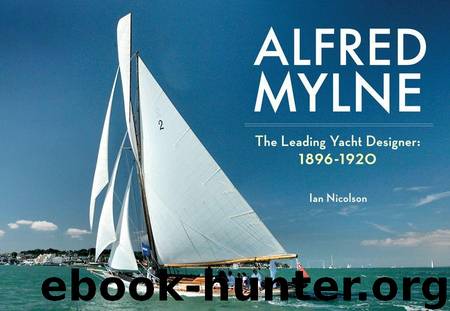Alfred Mylne: The Leading Yacht Designer: 1896-1920 by Nicolson Ian

Author:Nicolson, Ian [Nicolson, Ian]
Language: eng
Format: azw3, epub
Publisher: Amberley Publishing
Published: 2015-06-15T16:00:00+00:00
CHAPTER 16
Clyde One Design Class
Design No. 41
Length overall: 50 ft; 15.24 m.
Length waterline: 35 ft; 10.668 m.
Beam: 11 ft; 3.353 m.
Draft: 8 ft; 2.438 m.
Sail areas: 1715 sq. ft; 159.32 sq. m nominal, including mainsail, fore triangle and topsail
Built in 1899.
The design of a yacht is a balancing act, compared with which walking a tight-rope is as easy as falling off a log. A good example of this need to assess advantages and disadvantages at every stage in the design is seen in the bottom of the ballast keel, which is a straight horizontal line. Every designer of this general type of yacht has a problem getting the fore-end of the ballast keel as low as possible to give good stability, so a horizontal line makes eminent sense. However, if the yacht is trimmed down by the bow, then what was a horizontal line now dips down at the fore-end. This can result in a low pressure area along the bottom of the keel and steering problems may occur in windy weather.
There’s more. When running fast downwind, a wave may lift the stern, so the underside of the keel becomes higher at the aft end, just when reliable positive steering is urgently needed. If the underside of the keel was flat, as it is in many designs when the aim is to get as much metal ballast as low as possible, this aft upward slope can be a worry. However, all the sections in this design are fully-rounded keel, so the chances of negative pressure on the aft end of the keel base are reduced, probably to near zero.
Most Mylne designs have the fore-end of the keel base higher than the aft end in what might be described as the conventional way. One subsidiary reason is that slipping a boat on a marine railway is simpler and safer with that shape. By 1911, when Mylne owned the small boatyard called Bute Slip Dock with his brother, he would want every yacht to be easy to bring ashore on the marine railway.
The load waterline is far fuller aft than forward, as in virtually all fast boats. This is partly because the bow sections have to fight through the waves, so the finer they are, the less water has to be shouldered aside. Just as important, the yacht must have a tendency to surge to windward as she heels, and the full aft sections ensure this happens because the stern is raised relative to the bow. This counteracts the negative or downward pull of the water flow as it accelerates up the stern.
The original sail plan was typical of its time, with three small headsails. The three paid hands would not have too much trouble sheeting these in at each tack, as the staysail and lower jib sheets were through blocks, giving a two-to-one purchase. There were no sheet winches when this class was started. It was not until the 1930s, when large overlapping headsails became all the rage, that sheet winches became common and indeed essential.
Download
Alfred Mylne: The Leading Yacht Designer: 1896-1920 by Nicolson Ian.epub
This site does not store any files on its server. We only index and link to content provided by other sites. Please contact the content providers to delete copyright contents if any and email us, we'll remove relevant links or contents immediately.
MESSERSCHMITT Bf 109 by Chris Goss(520)
A History of the World in 500 Walks by Sarah Baxter(464)
Chevrolet 1960–2012 by Davis Michael W. R(424)
Warships of the Napoleonic Era by Robert Gardiner(420)
Spitfire: A Very British Love Story by John. Nichol(366)
Three’s Company by Jack T. C. Long(352)
Fodor's Tokyo by Fodor's Travel Guides(347)
Frommer's EasyGuide to Tokyo, Kyoto and Western Honshu by Beth Reiber(343)
Alfred Mylne: The Leading Yacht Designer: 1896-1920 by Nicolson Ian(333)
Focke-Wulf Fw 190 by CHRIS GOSS(320)
Off Grid Mobile Solar Power Installation in 1 Hour : A Step by step Guide to Design and install 12 Volts Solar Power System on Vans, RVS, Boats and Mobile Homes by Barone Larry & Barone Larry(316)
Microsoft Teams 2020 Crash Course: A Microsoft Teams Cheat Sheet and Quick Reference Guide for Beginners, Teachers and Educators by Steve Carter & Steve Carter(302)
Mustang and the Pony Car Revolution by Davis Michael W. R(301)
Midtown Sacramento by William Burg(283)
NASCAR Then and Now by Ben White(271)
Rails Across Ontario by Ron Brown(254)
The Space Shuttle Endeavour (Images of Modern America) by Silberkraus Stephen Hayward(195)
